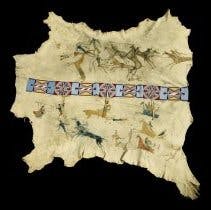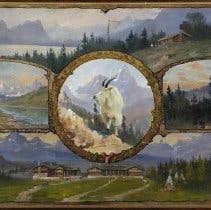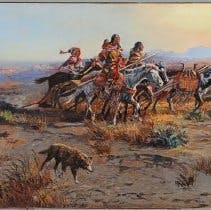Montana Historical Society
The Montana Historical Society (MTHS) was established in Virginia City in 1865 before Montana was even a state. It became a state agency in 1891 (22-3-101 MCA) and is charged with "the use, learning, culture, and enjoyment of the citizens of the state and for the acquisition, preservation, and protection of historical records, art, archival, and museum objects, historical places, sites, and monuments and the custody, maintenance, and operation of the historical library, museums, art galleries, and historical places, sites, and monuments."

The Montana Historical Society is raising an additional $60 million in funding for the Montana Heritage Center. Support our cause and donate here.
Financing & Legislation
Learn more about the legislation process and how this building is being financed here.
Montana Heritage Center - Project Phases
The project from start to finish includes multiple phases.

The site selection phase included evaluation of sites within a 10-mile radius around the Capitol Complex, including the Legislature’s previously designated location at Sixth and Roberts, the former Capitol Hill Mall site on 11th Avenue, the Padbury Ranch, current state-owned land near the Montana Department of Transportation, and airport property.
The Sixth and Roberts site was selected in 2020 based on a report by Cushing Terrill (CT). The main needs determined throughout the site selection process were for access, visibility, and parking. These items remain important throughout the entire project.

A preliminary concept for the Montana Heritage Center was developed in 2010, but in 2020 we restarted the design process from the beginning not only to update the concept, but to incorporate new directives and priorities.
This is the first building constructed on the Capitol campus since 1984. The Building and the Steering committee members were directed to aspire to the highest standards of efficiency and sustainability for the design. The committees are exploring ways to make this building as efficient as possible, including pursuing high-level third-party certifications, such as USGBC LEED or the Green Building Initiative.
The Building Committee is tasked with determining the structure, design, and look of the Heritage Center, with consideration to the needs of the Montana Historical Society, the Capitol Complex, and the public.
The design phase is expected to last 12-18 months and is analyzing in detail the Historical Society’s spatial needs, then creating requirements and finalizing building plans.

During the early stages of the design phase, general contractor Sletten Construction was selected using an alternative delivery/request for proposals process. This method maximizes budget and schedule control through real-time cost estimating, phasing analysis, constructability reviews of the design, and early collaboration among all project team members.
Construction activities started in Fall 2020 with relocation of the Capitol campus maintenance shops and major utilities, removal of small structures, and clearance of the site. This work was essential to prepare the site to expand parking for the 67th Legislature’s 2021 session and to commence full construction of the Montana Heritage Center in Summer 2021.
To allow the Montana Historical Society to remain open and operating as much as possible, the current phasing concept involves construction of the addition (the Heritage Center) from Summer 2021 to Summer 2023, then takes on upgrades to the existing Veterans and Pioneers Memorial Building (the current Historical Society facility) for approximately 18 months, with a grand re-opening planned for 2025.

The Montana Heritage Center will capture the grandeur of the Treasure State by celebrating the natural features, diverse cultures, and stories of our past. After years of hard work, consensus building, and careful design, the new home for the Montana Historical Society will include expanded museum exhibits, educational classrooms, a public event center, an enhanced research center, and a cafe, plus an outdoor courtyard and rooftop terrace. Visitors from across Montana and the world will experience state-of-the-art displays of our ever-expanding collections, only a few steps away from the Capitol building.
Hearing the excited voices of visitors of all ages while exploring the new Heritage Center and watching them learn what it means to be a Montanan will be a constant reminder of why this is such a special place.
Project Committees
The Steering Committee is an ad hoc committee, which oversees and sets direction for the Building Committee when needed.
The Building Committee’s task is to consider the current, future, and projected needs of the Montana Historical Society, the Capitol Complex, and the public, paying special attention to the Society’s responsibilities and mission.
Committee members for this project were selected based on the specific responsibilities related to their position and their expertise or knowledge of the specific project type or programs served in general; or to represent the interests of a particular constituent group. Steering Committee members also may serve on the Building Committee as appropriate due to their respective positions.
The committees will report to Department of Administration director throughout the project.

Tribal Involvement
Montana’s Museum is a place for learning, collaborating, and building relationships from corner to corner and everywhere in between. To turn this vision into a successful reality, it’s imperative we capture design-phase impressions and input from Montana's Tribal Nations as the Montana Heritage Center moves forward. The project team is collaborating with a group of advisors to help establish relationships, provide status updates, and act as a liaison with tribal leadership and communities.

Montana Historical Society
The Montana Historical Society (MTHS) was established in Virginia City in 1865 before Montana was even a state. It became a state agency in 1891 (22-3-101 MCA) and is charged with "the use, learning, culture, and enjoyment of the citizens of the state and for the acquisition, preservation, and protection of historical records, art, archival, and museum objects, historical places, sites, and monuments and the custody, maintenance, and operation of the historical library, museums, art galleries, and historical places, sites, and monuments."

The Montana Historical Society is raising an additional $60 million in funding for the Montana Heritage Center. Support our cause and donate here.
Financing & Legislation
Learn more about the legislation process and how this building is being financed here.
Montana Heritage Center - Project Phases
The project from start to finish includes multiple phases.

The site selection phase included evaluation of sites within a 10-mile radius around the Capitol Complex, including the Legislature’s previously designated location at Sixth and Roberts, the former Capitol Hill Mall site on 11th Avenue, the Padbury Ranch, current state-owned land near the Montana Department of Transportation, and airport property.
The Sixth and Roberts site was selected in 2020 based on a report by Cushing Terrill (CT). The main needs determined throughout the site selection process were for access, visibility, and parking. These items remain important throughout the entire project.

A preliminary concept for the Montana Heritage Center was developed in 2010, but in 2020 we restarted the design process from the beginning not only to update the concept, but to incorporate new directives and priorities.
This is the first building constructed on the Capitol campus since 1984. The Building and the Steering committee members were directed to aspire to the highest standards of efficiency and sustainability for the design. The committees are exploring ways to make this building as efficient as possible, including pursuing high-level third-party certifications, such as USGBC LEED or the Green Building Initiative.
The Building Committee is tasked with determining the structure, design, and look of the Heritage Center, with consideration to the needs of the Montana Historical Society, the Capitol Complex, and the public.
The design phase is expected to last 12-18 months and is analyzing in detail the Historical Society’s spatial needs, then creating requirements and finalizing building plans.

During the early stages of the design phase, general contractor Sletten Construction was selected using an alternative delivery/request for proposals process. This method maximizes budget and schedule control through real-time cost estimating, phasing analysis, constructability reviews of the design, and early collaboration among all project team members.
Construction activities started in Fall 2020 with relocation of the Capitol campus maintenance shops and major utilities, removal of small structures, and clearance of the site. This work was essential to prepare the site to expand parking for the 67th Legislature’s 2021 session and to commence full construction of the Montana Heritage Center in Summer 2021.
To allow the Montana Historical Society to remain open and operating as much as possible, the current phasing concept involves construction of the addition (the Heritage Center) from Summer 2021 to Summer 2023, then takes on upgrades to the existing Veterans and Pioneers Memorial Building (the current Historical Society facility) for approximately 18 months, with a grand re-opening planned for 2025.

The Montana Heritage Center will capture the grandeur of the Treasure State by celebrating the natural features, diverse cultures, and stories of our past. After years of hard work, consensus building, and careful design, the new home for the Montana Historical Society will include expanded museum exhibits, educational classrooms, a public event center, an enhanced research center, and a cafe, plus an outdoor courtyard and rooftop terrace. Visitors from across Montana and the world will experience state-of-the-art displays of our ever-expanding collections, only a few steps away from the Capitol building.
Hearing the excited voices of visitors of all ages while exploring the new Heritage Center and watching them learn what it means to be a Montanan will be a constant reminder of why this is such a special place.
Project Committees
The Steering Committee is an ad hoc committee, which oversees and sets direction for the Building Committee when needed.
The Building Committee’s task is to consider the current, future, and projected needs of the Montana Historical Society, the Capitol Complex, and the public, paying special attention to the Society’s responsibilities and mission.
Committee members for this project were selected based on the specific responsibilities related to their position and their expertise or knowledge of the specific project type or programs served in general; or to represent the interests of a particular constituent group. Steering Committee members also may serve on the Building Committee as appropriate due to their respective positions.
The committees will report to Department of Administration director throughout the project.

Tribal Involvement
Montana’s Museum is a place for learning, collaborating, and building relationships from corner to corner and everywhere in between. To turn this vision into a successful reality, it’s imperative we capture design-phase impressions and input from Montana's Tribal Nations as the Montana Heritage Center moves forward. The project team is collaborating with a group of advisors to help establish relationships, provide status updates, and act as a liaison with tribal leadership and communities.














